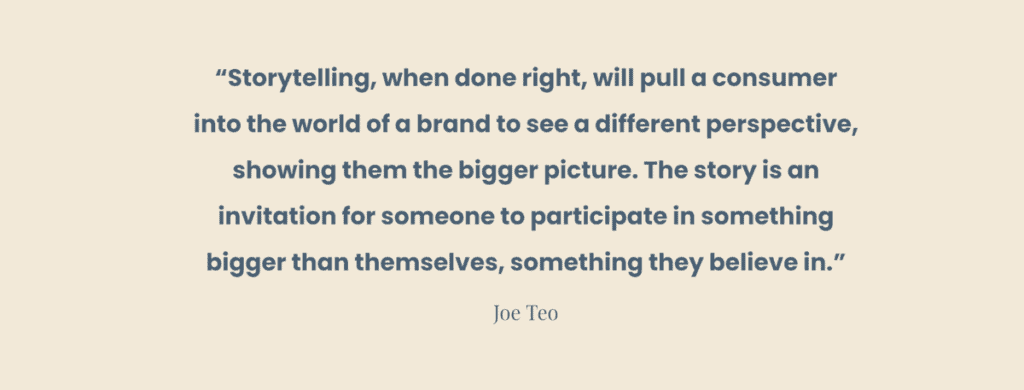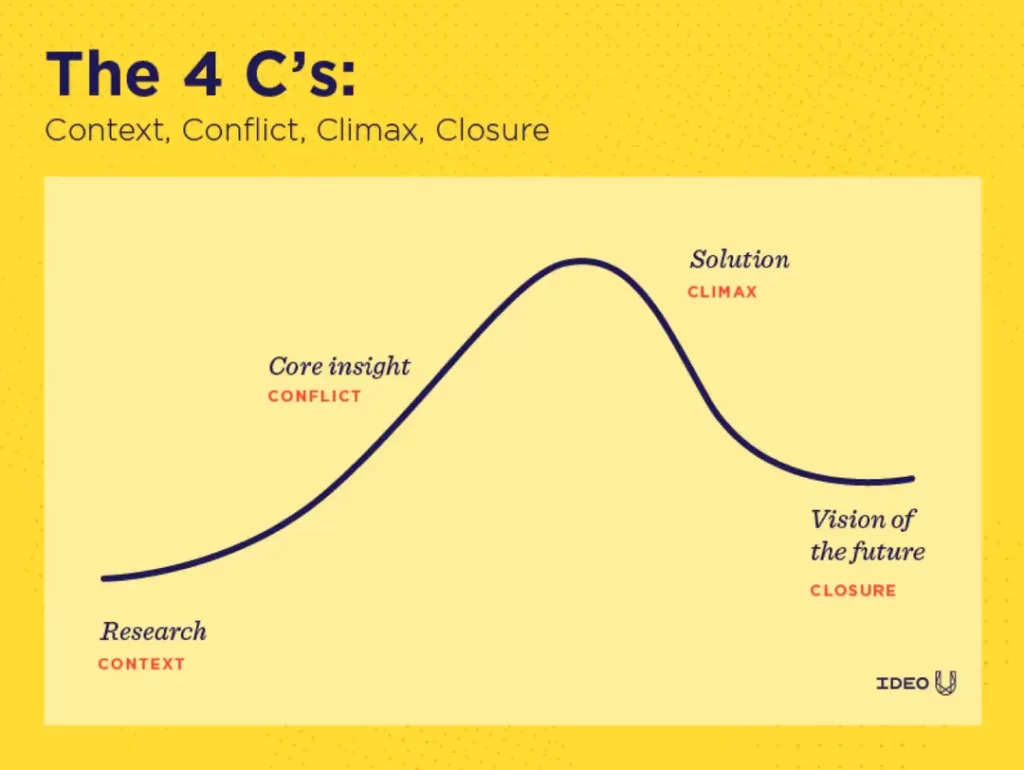Brand Narrative: Creating a Compelling Story for Your Brand
In our cutthroat business world, having a brand narrative is essential. We're not just talking about a catchy slogan or cool logo; it's more like what your brand stands for and why anyone should care.
A brand narrative is the story you tell about your brand – and it helps make that emotional connection with customers.
Getting your brand narrative right requires careful thought. It means identifying those core values and beliefs that define you as an organisation – and then finding ways to weave them into your story so you stand out from competitors and offer something unique.
A well-crafted brand narrative can help attract potential customers, engage existing ones more, build loyalty towards your company, and ultimately drive business growth.
Table of Contents
How a Brand Narrative Helps in Creating a Strong Brand Identity

The importance of a brand narrative lies in the way it helps build a powerful brand identity that resonates with customers. It moves beyond product attributes and benefits to explore the emotional side of a brand. A robust and vibrant brand narrative can elicit emotions, forge connections and build relationships with your audience.
For instance, consider Nike's brand narrative. It is built around empowering athletes to achieve their best by going beyond their limits. Such an approach has helped Nike establish an athletic, determined, successful personality for its brand. By telling a story that reflects what its target audience aspires to or values most, Nike has created a stand-out position for itself in an otherwise cluttered market.
Critical Elements of a Compelling Brand Narrative
To build a compelling brand narrative, several ingredients must be mixed well. First up: a good creation story, which explains where the brand comes from and what it's for. The best will mean something: why does the world need your business? Because this is what your audience thinks, too.
Next up, create a creed: find three guiding principles or values that encapsulate why you exist. This will help give your business direction – and attract people who believe in those same things.
It helps to articulate what hurdles non-believers might put against your idea here, too: addressing doubts, head-on shows transparency and authenticity, two attributes vital to any successful brand story.
Icons are also essential: things like symbols or characters (think Tony the Tiger) that become shorthand for your ideas – part of the visual language of whatever you're doing.
Like rituals? Would some annual event – think Red Bull's Flugtag or Notting Hill Carnival – help unite people around your mission?
A unique lexicon can also make otherwise ho-hum brands feel more attractive. Think about how Virgin talks about ‘the customer journey' rather than ‘customer service. How could investing in creating new jargon help build a sense of belonging?
Finally, having one charismatic leader (or fictional character) who sums everything up can help cement everything together. What would Ronseal do?
Once again, get into the detail with this exercise by forcing yourself to write 300 words on each topic before moving on.
Examples of Successful Brand Narratives

Crafting compelling brand narratives that resonate with a target audience can be seen in multiple successful brands. Coca-Cola, for one, has built a narrative around happiness, togetherness and sharing. It uses advertising that shows people enjoying joy and connection when drinking a Coke. This narrative has helped create an emotional bond between the global community that shares this positive experience.
Another example is Apple, which focuses on innovation, simplicity and creativity with its brand narrative. Its stories are about empowering individuals to think differently, challenge the status quo and unleash their creative potential.
These cases highlight how well-crafted brand narratives can help establish an emotional bond with consumers and differentiate a business from rivals by tapping into what makes them tick.
Techniques for Crafting an Effective Brand Narrative
Crafting a powerful brand story is part art, part science. One technique that can be helpful is to identify the core beliefs and values of your brand and weave those into the narrative. By understanding what you stand for and what you want to achieve, you can create a story that reflects your fundamental values – which in turn will resonate with your target audience.
Another critical step is to understand who precisely this target group is; it's only by truly understanding their needs, motivations, aspirations and emotions that brands can create stories that talk directly to them – stories they'll care about.
Using storytelling techniques helps, too. Think relatable characters; think conflict and resolution; consider visual elements used cleverly: all help make the story engaging and memorable.
Telling stories that generate solid emotions or capture an audience's imagination also enormously impacts how well-received a narrative is. So it's worth spending time getting these right.
But even a brilliantly crafted piece of content won't deliver against objectives if nobody sees or engages with it. That's why considering how best to amplify your brand narrative through different media platforms such as video, social media or blogs – leveraging each platform for its unique storytelling opportunities and reach is crucial too.
Using some techniques and refining every aspect of your brand story consistently over time, you should be able to engage audiences around whatever you're trying to say or communicate at any given time.
The Role of Brand Storytelling in Branding

The art of brand storytelling is crucial to successful branding because it can forge an emotional bond between brands and their target audience. It offers a way for them to communicate their unique selling proposition, values, and purpose in an engaging and relatable manner. Companies can create trust, loyalty, and affinity by telling tales that resonate with the target people.
Brand storytelling goes above and beyond simply explaining why someone should buy a product or service – it taps into the emotions, desires, aspirations, and beliefs that drive customer behaviour. Companies can build deep connections with customers by connecting with these emotions through narrative techniques like plot development and character creation.
For example, TOMS Shoes has built its entire brand narrative around its mission to give back by providing shoes to needy children with every purchase. But by telling this story so consistently – think about how many times you have seen this message reflected on Toms' website or social media channels – the company has created something more than just footwear; it has established a community of like-minded individuals who support its values.

Brand storytelling also contributes towards overall brand messaging by offering frameworks for communication. It helps define what makes an offer unique while ensuring each content is aligned with a broader set of values or strategic goals. Consistency also plays a significant role here; choose one theme for your brand narrative, then stick to it across all channels.
Brand storytelling is essential if firms are looking to create an emotional connection between their products/services and target audience; communicate their purpose/values/unique selling proposition in an engaging/relatable way; differentiate themselves from competitors; tap into consumer behaviour drivers (i.e., consumers aren't driven solely by product/service features/benefits but elements such as emotion/aspiration/value); tell authentic stories which will make people connect/identify/share personal experiences; attribute human characteristics (e.g., Disney's Mickey Mouse)
How a Brand Narrative Attracts and Engages the Target Audience
Mastering the art of storytelling is critical to attracting and engaging target audiences. Like other marketing tools, a brand narrative can create relevance and connection by tapping into people's emotions, values, and aspirations.
The more consumers connect with your brand's story, the greater their affinity will be for what you sell – and the louder they'll shout about it.
Take the outdoor clothing company Patagonia. Its brand story is all about environmental sustainability and responsible consumption. It has attracted a fanatically dedicated audience by appealing to its customers' passions: telling them a story about their love of the great outdoors and their concern for protecting it.

Such stories are only compelling if they resonate with core customer desires or needs. They must also feel authentic – an essential quality in this age of corporate mistrust – and emotionally pleasing.
While understanding your target audience is crucial, so is crafting narratives that give them something they want or need.
Aligning Brand Narrative with Product Development
The product's unique features and benefits must be incorporated into the narrative to guarantee that a brand narrative is congruent with product development and remains authentic. A holistic, cohesive consumer experience can then be constructed.
For example, Tesla's electric vehicles reflect its brand narrative of cutting-edge technology and sustainable transport. This demonstrates how design, performance and features underline the company's commitment to sustainability and innovation.

Bringing together the brand narrative with every element of product development guarantees no continuity or consistency breaks for consumers.
This helps convey what a company stands for through its products or services. It also communicates their mission or purpose more effectively than if they were separate entities.
Making sure what is promised through a brand story is upheld by product development enables companies to create an authentic customer experience based on their principles or values.
Potential Advantages and Disadvantages of Creating a Strategic Brand Narrative

Crafting a strategic brand narrative can bring many benefits. It helps set your brand apart from competitors, build a strong brand identity and establish an emotional connection with consumers. A well-managed narrative is also likely to improve communication by providing a framework for it and helping articulate the unique value proposition of your brand more effectively.
If you tell compelling stories that resonate with customers, you're likely to earn their trust, loyalty and affinity, too — which, in turn, can grow your business by attracting new customers. If people connect with your story or values, they are more likely to choose your products over those of rivals — so crafting a narrative that works well and stands out could give you a competitive advantage in attracting new customers.
That said, potential disadvantages are associated with creating a strategic brand narrative. Doing it properly requires careful planning and execution; if you don't do this work upfront when you reveal what's been made, there's every chance it will confuse the people who matter most: your target audience. And if they don't get what you've tried to achieve, the whole exercise is pointless.
A poorly crafted brand narrative may fail to connect emotionally with consumers, meaning marketers miss the mark entirely.
Moreover, as time progresses, narratives need to evolve — something that companies often lose sight of because everyone gets caught up in other stuff, such as technology upgrades or ensuring website content remains current.
Consumer preferences change, however (as do trends), so brands must stay relevant by updating narratives accordingly; otherwise, they risk losing resonance because other brands might have evolved theirs (a bit like not bothering about mobile optimisation for five years only to find rivals already had done so).
In summary, in any case? Creating a compelling strategic brand narrative brings much upside:
- Differentiation from others operating in the same sector.
- Improved recognition of marketing messages among target audiences.
- Better articulation of why customers should buy into what's being offered, increasing the likelihood of trust and loyalty.
- Greater prospect of attracting new customers, too.
Downside? There isn't one, really — so long as brand owners recognise this discipline should be adequately crafted, not something to whack out in a rush and move on from.
Conclusion
Crafting a compelling brand narrative is crucial for brands that want to develop a strong identity, engage with consumers and stand out. It can establish an emotional connection between the brand and its audience to drive lasting relationships.
A brand narrative should align with a business's values, purpose and target market while being capable of grabbing attention when told repeatedly across different channels. It should also differentiate the brand in some way.
“A brand narrative is based on what we call ‘brand story architecture',” says Rafiq Elmansy at digital design agency Adobe Lightroom. “It's not just about storytelling; it's about creating a structure that allows you to tell stories that resonate together.”
There are seven components of this architecture:
- Your creation story (how the company came into being).
- Creed (the principles or beliefs behind your work).
- Icons (particularly vivid images or symbols associated with your business that can be used in marketing material).
- Rituals (behaviours related to your products or services – think how Apple users keep buying devices as they integrate well);
- Lexicon (“a language or special vocabulary associated” with your industry – think tech buzzwords such as agile methodology);
- Non-believers (people who may doubt your product)
- And leader (who leads the charge).
All seven don't need to feature in every story you tell.
Two successful examples of using storytelling techniques within branding are Coca-Cola's ads featuring the holidays-themed truck, which has run since 1995, and Apple co-founder Steve Jobs' launch presentations for new iPhones over several years beginning in 2007.
Coca-Cola uses both push-and-pull advertisings: Hoover up some Coke nostalgia today! Oh no, wait, there is still some available!
With its truck ad campaign running for over two decades now, “they're tapping into something deep”, says Harvard professor emeritus Gerald Zaltman. “If you think about it, what could be more boring than a soft drink? But they've had an ad campaign for 20 years: Santa Claus and the truck. What's that got to do with a soft drink?”
Jobs' presentation style was designed to make you feel like one of the cool kids if you bought into his product. The other smartphone makers are making rubbish. We have created something beautiful and unique.
While these examples are from different sectors – one is FMCG, the other tech – both show how brands can tap their audience's emotions or values through storytelling techniques.
